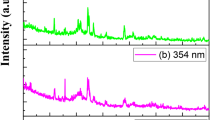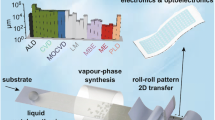Abstract
Indium–zinc oxide nanostructures, such as nanosheets, nanobelts, and wires formed by oriented stacks of nanoplates have been grown by a controlled thermal evaporation method without the use of a foreign catalyst. Surface features in the stacked hexagonal nanoplates suggest a dislocation-driven growth mechanism for these structures. A growth model for these stacks is proposed based on changes in velocity growth rate between the outer and the inner part of the plates. Zn incorporation has been investigated by means of energy-dispersive spectroscopy, X-ray photoelectron spectroscopy, and selected area electron diffraction. The formation of Zn k In2O k+3 ternary compounds has been demonstrated. Cathodoluminescence emission and its correlation with the morphology of the structures and Zn content have been studied.






Similar content being viewed by others
References
Alemán B, Fernández P, Piqueras J (2009) Indium-zinc-oxide nanobelts with superlattice structure. Appl Phys Lett 95:013111
Alemán B, Fernández P, Piqueras J (2010) Dense vertical nanoplates arrays and nanobelts of indium doped ZnO grown by thermal treatment of ZnS–In2O3 powders. J Cryst Growth 312:3117–3120
Alemán B, Ortega Y, García JA, Fernández P, Piqueras J (2011) Fe solubility, growth mechanism, and luminescence of Fe doped ZnO nanowires and nanorods grown by evaporation–deposition. J Appl Phys 110:014317
Bartolomé J, Maestre D, Cremades A, Amati M, Piqueras J (2011) Indium zinc oxide pyramids with pinholes and nanopipes. J Phys Chem C 115:8354–8360
Bartolomé J, Maestre D, Cremades A, Amati M, Piqueras J (2013) Composition-dependent electronic properties of indium–zinc–oxide elongated microstructures. Acta Mater 61:1932–1943
Bierman MJ, Lau YKA, Kvit AV, Schmitt AL, Jin S (2008) Dislocation-driven nanowire growth and Eshelby twist. Science 320:1060–1063
Cherns D, Meshi L, Griffiths I, Khongphetsak S, Novokov SV, Farley NRS, Campion RP, Foxon CT (2008) Defect-controlled growth of GaN nanorods on (0001)sapphire by molecular beam epitaxy. Appl Phys Lett 93:111911
Coleman JN, Lotya M, O’Neill A, Bergin SD, King PJ, Khan U, Young K, Gaucher A, De S, Smith RJ et al (2011) Two-dimensional nanosheets produced by liquid exfoliation of layered materials. Science 331:568–571
Fan JCC, Goodenough JB (1977) X-ray photoemission spectroscopy studies of Sn-doped indium-oxide films. J Appl Phys 48:3524–3531
Gaarenstroom SW, Winograd N (1977) Initial and final state effects in the ESCA spectra of cadmium and silver oxides. J Chem Phys 67:3500–3506
Geim AK (2009) Graphene: status and prospects. Science 324:1530–1534
Guha P, Kar S, Chaudhuri S (2004) Direct synthesis of single crystalline In2O3 nanopyramids and nanocolumns and their photoluminescence properties. Appl Phys Lett 85:3851–3853
Hosono E, Fujihara S, Honma I, Zhou H (2005) The fabrication of an upright-standing zinc oxide nanosheet for use in dye-sensitized solar cells. Adv Mater 17:2091–2094
Hsin CL, He JH, Chen LJ (2006) Modulation of photoemission spectra of In2O3 nanowires by the variation in Zn doping level. Appl Phys Lett 88:063111
Jeong JS, Lee JY, Lee CJ, An SJ, Yi G-C (2004) Synthesis and characterization of high-quality In2O3 nanobelts via catalyst-free growth using a simple physical vapor deposition at low temperature. Chem Phys Lett 384:246–250
King PDC, Veal TD, Fuchs F, Wang CY, Payne DJ, Bourlange A, Zhang H, Bell GR, Cimalla V, Ambacher O et al (2009) Band gap, electronic structure, and surface electron accumulation of cubic and rhombohedral In2O3. Phys Rev B 79:205211
Kumar B, Gong H, Akkipeddi R (2005) A study of conduction in the transition zone between homologous and ZnO-rich regions in the In2O3–ZnO system. J Appl Phys 97:063706
Lao JY, Huang JY, Wang DZ, Ren ZF, Steeves D, Kimball B, Porter W (2004) ZnO nanowalls. Appl Phys A 78:539–542
Lee MS, Choi WC, Kim EK, Kim CK, Min SK (1996) Characterization of the oxidized indium thin films with thermal oxidation. Thin Solid Films 279:1–3
Ley L, Pollak RA, McFeely FR, Kowalczyk SP, Shirley DA (1974) Total valence-band densities of states of III–V and II–VI compounds from X-ray photoemission spectroscopy. Phys Rev B 9:600–621
Li J, Fan H, Jia X (2010) Multilayered ZnO nanosheets with 3D porous architectures: synthesis and gas sensing application. J Phys Chem C 114:14684–14691
Maestre D, Häussler D, Cremades A, Jäger W, Piqueras J (2011a) Nanopipes in In2O3 nanorods grown by a thermal treatment. Cryst Growth Des 11:1117–1121
Maestre D, Häussler D, Cremades A, Jäger W, Piqueras J (2011b) Complex defect structure in the core of Sn-Doped In2O3 nanorods and its relationship with a dislocation-driven growth mechanism. J Phys Chem C 115:18083–18087
Magdas DA, Cremades A, Piqueras J (2006) Growth and luminescence of elongated In2O3 micro- and nanostructures in thermally treated InN. Appl Phys Lett 88:113107
Mandal A, Mitra S, Datta A, Banerjee S, Dhara S, Chakravorty D (2012) Multiphonon scattering and photoluminescence of two dimensional ZnS nanosheets grown within Na-4 mica. J Appl Phys 112:074321
Mazzera M, Zha M, Calestani D, Zappettini A, Lazzarini L, Salviati G, Zanotti L (2007) Low-temperature In2O3 nanowire luminescence properties as a function of oxidizing thermal treatments. Nanotechnology 18:355707
Meng F, Jin S (2011) The solution growth of copper nanowires and nanotubes is driven by screw dislocations. Nano Lett 12:234–239
Morin SA, Jin S (2010) Screw dislocation-driven epitaxial solution growth of ZnO nanowires seeded by dislocations in GaN substrates. Nano Lett 10:3459–3463
Morin SA, Bierman MJ, Tong J, Jin S (2010) Mechanism and kinetics of spontaneous nanotube growth driven by screw dislocations. Science 328:476–480
Morin SA, Forticaux A, Bierman MJ, Jin S (2011) Screw dislocation-driven growth of two-dimensional nanoplates. Nano Lett 11:4449–4455
Na CW, Bae SY, Park J (2005) Short-period superlattice structure of Sn-doped In2O3(ZnO)4 and In2O3(ZnO)5 nanowires. J Phys Chem B 109:12785–12790
Ng HT, Li J, Smith MK, Nguyen P, Cassell A, Han J, Meyyappan M (2003) Growth of epitaxial nanowires at the junctions of nanowalls. Science 300:1249
Pradhan D, Kumar M, Ando Y, Leung KT (2008) Efficient field emission from vertically grown planar ZnO nanowalls on an ITO-glass substrate. Nanotechnology 19:035603
Shen G, Bando Y, Lee C-J (2005) Growth of self-organized hierarchical ZnO nanoarchitectures by a simple In/In2S3 controlled thermal evaporation process. J Phys Chem B 109:10779–10785
Singh N, Yan C, Lee PS (2010) Room temperature CO gas sensing using Zn-doped In2O3 single nanowire field effect transistors. Sens Actuatators B 150:19–24
Tang Q, Zhou W, Zhang W, Ou S, Jiang K, Yu W, Qian Y (2005) Size-controllable growth of single crystal In(OH)3 and In2O3 nanocubes. Cryst Growth Des 5:147–150
Wang NW, Yang YH, Yang GW (2009) Indium Oxide–Zinc oxide nanosized heterostructure and whispering gallery mode luminescence emission. J Phys Chem C 113:15480–15483
Yan Y, Zhou L, Zhang Y, Zhang J, Hu S (2008) Large-scale synthesis of In2O3 nanocubes under nondynamic equilibrium model. Cryst Growth Des 8:3285–3289
Yang H, Zhang R, Dong H, Yu J, Yang W, Chen D (2008) In situ growth of self-assembled and single In2O3 nanosheets on the surface of indium grains. Cryst Growth Des 8:3154–3159
Zhang W, Jie J, He Z, Tao S, Fan X, Zhou Y, Yuan G, Luo L, Zhang W, Lee CS et al (2008) Single zinc-doped indium oxide nanowire as driving transistor for organic light-emitting diode. Appl Phys Lett 92:153312
Zheng MJ, Zhang LD, Li GH, Zhang XY, Wang XF (2001) Ordered indium-oxide nanowire arrays and their photoluminescence properties. Appl Phys Lett 79:839–841
Zhu J, Peng H, Marshal AF, Barnett DM, Nix WD, Cui Y (2008) Formation of chiral branched nanowires by the Eshelby twist. Nat Nanotechnol 3:477–481
Acknowledgments
This work has been supported by Ministerio de Economía y Competitividad (Projects MAT 2012-31959, and Consolider CSD 2009-00013). J. Bartolomé acknowledges the financial support from Universidad Complutense de Madrid.
Author information
Authors and Affiliations
Corresponding author
Rights and permissions
About this article
Cite this article
Bartolomé, J., Maestre, D., Amati, M. et al. Two-dimensional Zn k In2O k+3 nanostructures: synthesis, growth mechanism, self-assembly, and luminescence. J Nanopart Res 15, 2015 (2013). https://doi.org/10.1007/s11051-013-2015-5
Received:
Accepted:
Published:
DOI: https://doi.org/10.1007/s11051-013-2015-5




